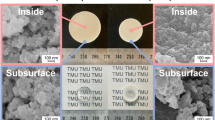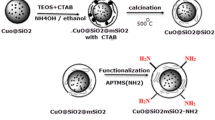Abstract
Spinnable solutions are obtained in the sol–gel system of tetraethoxide (TEOS, Si(OC2H5)4) and vinyltrimethoxysilane (VTMS, CH2=CHSi(OCH3)3) under aqueous condition (water) with acid catalysts (HNO3 and HCl). Polysiloxane (PSO) fibers are drawn from the solution and characterized by spectroscopic and structural analyses. 29Si-nuclear magnetic resonance NMR) spectral analysis of the PSO fiber indicates the incorporation of atomic carbon in the silica network. 13C-NMR analysis shows the existence of considerable amount of hydroxyl groups in the PSO fiber. The spinnablity of the solution is studied by varying the mole ratios of the alkoxides, solvents and catalysts as well as precursor chemistries. The amount of water and catalysts are found to be important for the attaining of a spinnable state in the solution. SiOC fibers are obtained after pyrolysis of the PSO fibers with a high ceramic yield (88 wt%). The high ceramic yield attributes to the incorporation of vinyl-groups in the gel fiber that enhances crosslinking during pyrolysis. The SiOC fiber has a tensile strength of 776 MPa and electrical conductivity of 3.6 × 10−4 S/m.







Similar content being viewed by others
References
Miele P, Bernard S, Cornu D, Toury B (2006) Recent developments in polymer-derived ceramic fibers (PDCFs): preparation, properties and applications–a review. Soft Mater 4(2–4):249–286
Baldus P, Jansen M, Sporn D (1999) Ceramic fiber for matrix composites in high-temperature engine applications. Science 285:699–703
Varshavskii VV (2004) Ceramic fibers, a review. Fibre Chem 25:1573–8493
Sakka S, Kamiya K (1982) The sol–gel transition in the hydrolysis of metal-alkoxides in relation to the formation of glass fibers and films. J Non-Cryst Solids 48:31–46
Kamiya K, Yoko T (1986) Synthesis of SiO2 glass fibers from Si(OC2H5)4–H2O-C2H5OH-HCl solutions through sol–gel method. J Mater Sci 21:842–848
Kamiya K, Iwamoto Y, Yoko T, Sakka S (1988) Hydrolysis and condensation reactions of Si(OC2H5)4 related to silica fiber drawing. J Non-Cryst Solids 100:195–200
Sakka S, Kozuka H (1988) Rheology of sols and fiber drawing. J Non-Cryst Solids 100:142–153
Kamiya K, Katayama A, Suzuki H, Nishida K, Hashimoto T, Matsuoka J, Nasu H (1999) Preparation of silicon oxycarbide glass fibers by Sol–Gel method effect of starting sol composition on tensile strength of fibers. J Sol Gel Sci Technol 14:95–102
Kolar F, Machovic V, Svitilova J, Borecka L (2004) Structural characterization and thermal oxidation resistance of silicon oxycarbides produced by polysiloxane pyrolysis. Mater Chem Phys 86:88–98
Cordelair J, Greil P (2000) Electrical conductivity measurements as a microprobe for structure transitions in polysiloxane derived Si-O-C ceramics. J Eur Ceram Soc 20:1947–1957
Colombo P, Gambaryan-Roisman T, Scheffler M, Buhler P, Greil P (2001) Conductive ceramic foams from preceramic polymers. J Am Ceram Soc 84:2265–2268
Colombo P, Hellmann JR (2002) Ceramic foams from preceramic polymers. Mater Res Innov 6:260–272
Riedel R, Gabriel M, Ralf H, Alexander K (1996) Silicon-based polymer-derived ceramics: Synthesis properties and applications—A review. Jpn J Ceram Soc 114:425–444
Hu Y (2000) Preparation of silicon oxycarbide glass fibers from organically modified silicates. J Mater Sci 35:3155–3159
Chen LF, Cai ZH, Zhou W, Lan X, Chen XJ (2005) Preparation and properties of silicon oxycarbide fibers. J Mater Sci 40:3497–3501
Chen LF, Cai ZH, Zhang L, Lan L, Chen XJ, Zeng J (2007) Preparation and properties of silicon oxycarbide fibers. J Mater Sci 42:1004–1009
Su D, Li YL, An HJ (2010) Pyrolytic transformation of liquid precursors to shaped bulk ceramics. J Eur Ceram Soc 30:1503–1511
Soraru GD, Liu Q, Interrante LV, Apple T (1998) Role of precursor molecular strucrure on the microstructure and high temperature stability of silicon oxycarbide glass derived from methylene-bridged polycarbosilanes. Chem Mater 10:4047–4054
Takamura N, Taguchi K, Gunji T, Abe Y (1999) Preparation of silicon oxycarbide ceramic films by pyrolysis of polymethy-and polyvinysilsesquioxanes. J Sol–Gel Sci Techno 16:227–234
Soraru GD (2000) Hybrid RSiO1.5/B2O3 gels from Modified Silicon alkoxides and boric acid. J Sol Gel Sci Technol 18:11–19
Alonso RP, Soraru GD (2007) Synthesis and characterization of hybrid borosiloxane gels as precursors for Si-B-O-C fibers. J Sol Gel Sci Technol 43:313–319
Mah SK, Chung IJ (1995) Effects of dimethyldiethoxysilane addition on tetraethylorthosilicate sol–gel process. J Non-Cryst Solids 183:252–259
Zhang ZP, Gorman BP, Dong HJ, Orozco-Teran RA, Mueller DW, Reidy RF (2003) Investigation of polymerization and crystallization of dimethyldiethoxysilane by 29Si NMR and FTIR. J Sol Gel Sci Technol 28:159–165
Kroke E, Li YL, Konetschny C, Lecomte E, Fasel C, Riedel R (2000) Silazane derived ceramics and related materials. Mater Sci Eng R 26:97–199
Lipowitz J (1991) Structure and properties of ceramic fibers prepared from organosilcon polymers. J Inorg Organomet Polym 3:277–297
Pantano CG, Singh AK, Zhang HX (1999) Silicon oxycarbide glass. J Sol Gel Sci Technol 14:7–25
Acknowledgments
This work is supported by the National Basic Research Program of China (Grant No. 2010CB934700), National Science Foundation for Distinguished Young Scholars (50625207), the Applied Fundamental and Frontier Research Foundation of Tianjin Municipal, and State Key Laboratory of Precise Measurement and Equipment, Tianjin University, China.
Author information
Authors and Affiliations
Corresponding author
Rights and permissions
About this article
Cite this article
Ruan, DS., Li, YL., Wang, L. et al. Fabrication of silicon oxycarbide fibers from alkoxide solutions along the sol–gel process. J Sol-Gel Sci Technol 56, 184–190 (2010). https://doi.org/10.1007/s10971-010-2292-8
Received:
Accepted:
Published:
Issue Date:
DOI: https://doi.org/10.1007/s10971-010-2292-8




